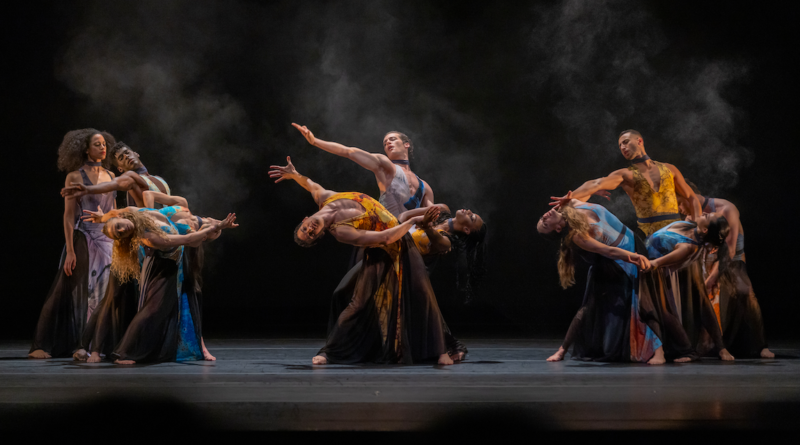INTERVIEW: Martha Graham Dance Company reimagines ‘Canticle’ from 1952
Photo: The Martha Graham Dance Company presents Canticle for Innocent Comedians. Photo courtesy of Luis Luque / Provided by press rep with permission.
The Martha Graham Dance Company is back for the City Center Dance Festival, which kicks off tonight, April 6, and continues through the weekend. For this run of shows, the celebrated dance company will present Canticle for Innocent Comedians, a new creation inspired by a largely lost work from 1952, according to press notes.
For Canticle, the artistic effort is truly collaborative, with multiple choreographers involved in the development of the piece. For example, Sonya Tayeh is the lead choreographer, and she’s responsible for the opening, closing, interludes and a vignette known as “Sun,” while “Alleyne Dance (Kristina and Sadé Alleyne), Jenn Freeman, Juliano Nunes, Micaela Taylor and Yin Yue have created ‘Earth,’ ‘Water,’ ‘Fire,’ ‘Stars’ and ‘Death,'” press notes indicate.
A special treat for audiences are the vignettes known as “Wind” and “Moon.” “Wind” has been given new life thanks to Sir Robert Cohan, who appeared in the original Canticle in 1952, and “Moon” features Graham’s original choreography. Jason Moran, the celebrated jazz composer, provides the score, and he will perform the music live on opening night.
Recently Hollywood Soapbox had the chance to exchange emails with Janet Eilber, artistic director of the Martha Graham Dance Company, and Freeman, associate choreographer of Canticle (she’s also responsible for a vignette in the show). Questions and answers have been slightly edited for style.
How did you and the company find out what was in the original Canticle if it was lost?
EILBER: The company has extensive archives and many resources for original source material on the Graham history, including the input of some of the original cast members of the 1952 version of Canticle for Innocent Comedians! We did research and interviews to unearth as much material and as many memories as we could. There were not enough clues to support an authentic reconstruction of the original dance. We did happily discover that the Graham original choreography for the section title “Moon” was filmed as part of a documentary in 1958. We use that piece of Graham’s choreography in our new production. All of the rest of the choreography is completely new.
Does the 2022 version look similar to the original, or is this one “inspired by” the original?
FREEMAN: As there was no archival footage of the original work other than Moon by Martha Graham, which was preserved and performed in its original form, each artist was commissioned to create a new vignette resulting in a new re-telling of Canticle for Innocent Comedians.
Do you feel it’s important to have dance that explores our relationship to nature?
FREEMAN: Exploring the themes of nature and its immense power and connecting with our environments spiritually through dance is an ancient human practice. I believe any artistic process that asks us to reflect upon our relation to the forces of the planet is an important reminder of our oneness. For me personally, working on “Death and Rebirth” came at a pivotal moment of transformation in my life. I found connecting to the many questions I have surrounding the meaning of death (not only one’s end of a life) was surprisingly comforting and healing in a time where hope (through rebirth) was what I, myself, needed the most.
What’s it like to set movement to Jason Moran’s music?
FREEMAN: Most of the movement for Canticle was created prior to hearing Jason’s score. In creating “Death and Rebirth,” I valued the time to explore movement alone and tried to take advantage of not having anything but my own imagery and ideas to work from. When I was able to listen to what Jason Moran composed for the first time, it was remarkable to find that feelings of flying, weightlessness, longing, and the vastness surrounding my visions of death and rebirth were all present in his (what I experienced as) hypnotic yet acutely minimalist score. On solo piano, he created a new sonic world for each vignette while finding a way to seamlessly weave each moment together.
What’s it like to work with multiple choreographers on a piece?
FREEMAN: In addition to choreographing “Death and Rebirth,” I am also lead choreographer Sonya Tayeh’s choreographic associate for this project. I was there to support Sonya in the incredibly ambitious task of building a piece that seamlessly weaves together the individual voices of nine choreographers from around the globe. Sonya had to draw upon her own choreographic voice for her vignette “Sun” as well as the opening, the finale, and all of the transitions while also considering and honoring the movement styles of eight other choreographers, including Martha Graham. Sonya also had to integrate the elements of a new score (created simultaneously) and a new costume design that would serve each vignette. Spanning over a year, the process of creating Canticle was evolutionary and ongoing up until the premiere.
Why has Martha Graham’s work continued to engage audiences? What is it about this dance vocabulary that has proved so enduring?
EILBER: Early in her career, Martha was determined to represent real human emotions and concerns in dance. She developed a style of movement that was based on unconscious gesture — body language. The Graham vocabulary is very physically and emotionally powerful because it is born out of movements that we all recognize and share as human beings! And her works are based on emotional themes that are part of all of our lives. She succeeded in her goal to “reveal the inner landscape of man” and “to chart a graph of the heart” in her dances.
By John Soltes / Publisher / John@HollywoodSoapbox.com
The Martha Graham Dance Company presents Canticle for Innocent Comedians April 6-10 at the City Center Dance Festival. Click here for more information and tickets.

